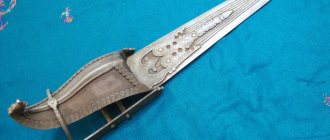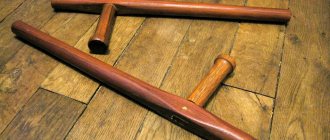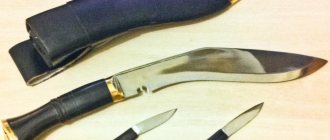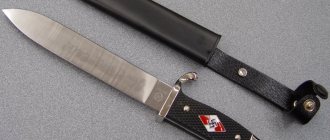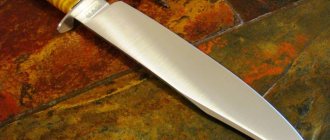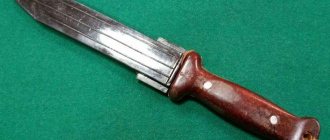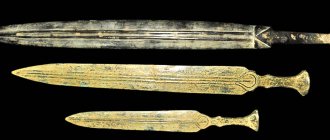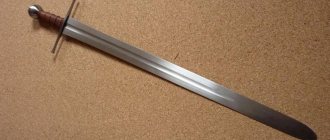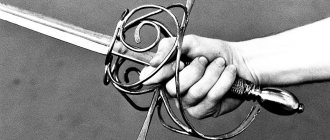Daga is a type of European short-bladed weapon designed to inflict a predominantly piercing blow on the enemy. This is a type of dagger that was held in the left hand when fencing with a sword. The French called the daga “men-goche”, which translated means “left hand”. The style of fencing was also called similarly, in which the fighter held weapons in both hands. In fact, the daga is a highly specialized edged weapon that was used as an addition to the sword or rapier.
In Europe, the daga dagger became most widespread in the period from the 15th to the 17th centuries. It was at this time that the European nobility was overwhelmed by the bloody “dueling fever,” which annually sent thousands of young aristocrats to the grave. The sword and dagger ended quarrels, defended noble honor, and put an end to the most complicated disputes.
Very quickly, the daga (dagger) from a weapon of common people became an invariable attribute of the nobility. With the help of the daga, the swordsman repelled the enemy's blows in battle; moreover, this dagger was an excellent tool for disarming the opponent. Currently, a large number of different varieties of dags are known; they differ in length, shape of the blade and guard, and country of origin.
An analogue of dagi also existed in Japan, it was called “sai”. In its shape, this dagger was very similar to its Western counterpart. However, unlike the European dagger, the sai was never an addition to other weapons. Moreover, it was never used by samurai nobles. It was originally an agricultural tool used by commoners, and later used quite readily by ninja spies.
Varieties of dag[edit]
Image of Spanish (Fig. 1) and German (Fig. 2) dag from the encyclopedic dictionary of Brockhaus and Efron (1890-1907)
Spanish dagaedit
To protect the hand, the Spanish daga has a wide plate in the form of a curved triangle, tapering towards the top of the handle (Spanish: en berceau
), often decorated with embossing.
The long straight arms of the guard are used to repel blows. The blade is flat, straight, single-edged, with a wide base (Spanish: ricasso
).
German dagaedit
The German daga has a trap for the enemy blade in the form of side blades diverging to the sides, driven by a special spring. It consists of two parts pivotally connected to the main blade, which are tilted to the sides by springs. The grips were released by pressing the handle lock button. If the enemy’s sword hit the trident thus obtained, the tip of the blade could break.
Japanese dagaedit
The Okinawan daga (sai) has a narrow round or multifaceted blade. The guard is a narrow bow directed forward in the direction of the blade. Unlike the European daga, it was not an addition to fencing weapons. The sai was not a samurai weapon at all - it was an agricultural tool. Moreover, the weapon was practically unknown in Japan, but was widely distributed in the Japanese vassal kingdom of Ryukyu. Also, the curved edges of the sai, in turn, being sharpened, formed additional blades, which was not observed in European dag guards.
The real Japanese daga is the jutte, which is similar to the sai, but has only one bow and a powerful thick faceted blade without sharpening or an edge, since the jutte was used as a sword and as a police baton. Since the Edo era police consisted of samurai, we can say that the jutte is, although very specific, still a samurai weapon. Being a police weapon for disarming a criminal armed with a sword and capturing him alive, unlike the European daga, the duztte, as a rule, was not used in conjunction with a sword. There was also a sharpened version of the jutte with a real sharpened blade - marohoshi, which for obvious reasons was not a police weapon.
Literature
- Bielenstein, Hans. (1980). The Bureaucracy of Han Times. Cambridge: Cambridge University Press. ISBN 0521225108.
- de Crespigny, Rafe. (2007). A Biographical Dictionary of Later Han to the Three Kingdoms (23-220 AD). Leiden: Koninklijke Brill. ISBN 9004156054.
- Dreyer, Edward H. (1988), "Military origins of Ming China", in Twitchett, Denis and Mote, Frederick W. (eds.), The Ming Dynasty, part 1, The Cambridge History of China, 7, Cambridge: Cambridge University Press, pp. 58–107, ISBN 9780521243322
- Ebrey, Patricia Buckley (1999). The Cambridge Illustrated History of China. Cambridge: Cambridge University Press. ISBN 0-521-43519-6 (hardback); ISBN 0-521-66991-X (paperback).
- Ji, Jianghong et al. (2005). Encyclopedia of Chinese History
Vol 1. Beijing publishing house. ISBN 7-900321-54-3. - Ji, Jianghong et al. (2005). Encyclopedia of Chinese History
Vol 2. Beijing publishing house. ISBN 7-900321-54-3. - Ji, Jianghong et al. (2005). Encyclopedia of Chinese History
Vol 3. Beijing publishing house. ISBN 7-900321-54-3. - Li, Bo and Zheng Yin. (Chinese) (2001). 5000 years of Chinese history. Inner Mongolian People's publishing corp. ISBN 7-204-04420-7.
- Graff, Andrew David. (2002) Medieval Chinese Warfare: 200—900. Routledge.
- Sun, Tzu, The Art of War, Translated by Sam B. Griffith (2006), Blue Heron Books, ISBN 1-897035-35-7.
The first dugs
The first left-handed daggers differed from their “father”, perhaps, only in the blade, which tended to be slightly leaf-shaped (they were wide, with a smooth narrowing towards the tip), always with long and forward-directed crosshairs, as well as a side ring on the guard. This type of dagger began to spread around 1550.
Blades began to become powerful, because... the sword at this time still retained the ability to cut, and a thinner blade could simply break. Here, for example, is a rapier and dagger from around the 1570s, made en suite:
T.N. dueling headset
In other cases, a left-handed dagger received an S-shaped guard - the upper quillon is directed forward so that the owner can try to catch the enemy sword between it and the blade, and the lower one is directed back, forming a half-arc to protect the hand:
Another paired set from around the same time
The hilts of left-handed daggers, just like swords, were always made of steel. The time for copper and brass hilts, fashionable in the 18th-19th centuries even for swords and sabers, has not yet come. The daga of that time, despite all its grace and beauty, was a military weapon. Its hilt was supposed to save the owner’s hand - in critical cases, withstanding the chopping blow of the sword.
The 16th-century daga cross-section was usually a slightly flattened diamond. Sometimes there was a narrow fuller the entire length of the blade. Subsequently, to improve balance, holes began to be made in the blades, mainly located at the guard.
Bottom line
This unusual dagger became one of the most famous weapons of the 15th -17th centuries. His ability to intercept an opponent's blade and deflect it to the side was irreplaceable. They were not allowed to duel without him due to the fact that there was no chance of survival.
Previous
Combat knivesKnife brass knuckles: what the popular street model is called and looks like
Next
Kitchen knivesKnife for cutting meat and fish: how not to make a mistake in choosing
Predecessor of Daga
There is no secret here - this is a quilon dagger, the “little brother” of the knight’s sword. It appeared in the 13th century, and reached the peak of its development in the 15th century, when from a weapon common in various strata of society it became purely knightly. Noble.
Late Quilon
The fact is that it was initially fashionable to make these weapons en suite
– in the same style, “at the same time” with the sword. The finishing of the hilt of such a dagger copied the finishing of the sword hilt. And the pommel was the same, and the quillons, i.e. crosshairs, and even the geometry of the blade was tried to be brought closer to the geometry of the sword - as far as possible. The quilon was most often worn on the belt on the right, in a position adapted for snatching with the right hand with a reverse grip. European knights preferred it for a dagger in 80% of cases - it was easier to inflict a deep wound on an enemy dressed in at least a durable quilted gambeson.
Engraving from Maciejewski's Bible
Note the warrior in the yellow cape in the right corner
Around the middle of the 15th century, civilian double-armed fencing began to take shape, where the shield, inconvenient in everyday use, was replaced with a dagger. Let me clarify: we are talking specifically about civilian, dueling “shaming”, not about combat. A shield is a bulky and inconvenient thing, constantly carrying it with you is a big hassle... Why not replace it with a dagger, which almost every swordsman of those years still had hanging from his belt?
This is how the quillon became a left-handed dagger.
Its fate was determined by the fact that only this dagger, of all the European ones, had a developed guard with a long guard - this is important! – forward-facing quillons – crosshair bars. Yes, it was because of them that it got its modern name
What is curious is that the manner of wearing such a dagger did not necessarily imply that it was suitable for being drawn with the left hand. Very often it was worn behind the back, at the level of the waist, with the handle to the right. In this position, it did not interfere with walking, and if necessary, it could be grabbed with its right hand to reflect the blow. And only then did he transfer to the left.
Activities in Russia
Sword: history of weapons, two-handed and bastard swords
The Chinese triad in Russia also has its own division located in the Far East. The main interests of the Chinese mafia in the Russian Federation are:
- transportation of timber from Siberia,
- export of seafood,
- trade and smuggling of narcotic substances, precious metals,
- mineral theft
The Chinese illegally export anything of any value. The triads bring back electronics, clothing, trinkets and counterfeits of famous brands. This product is distributed in Russia and is in demand, as the monthly turnover is $1 billion.
The Chinese mafia in Russia tries to maintain good relations with local gangs and corrupt officials. Instead of bloody showdowns and division of spheres of interest, the Chinese prefer profitable cooperation.
About combat use
The use of dag gave impetus to the emergence of new fencing techniques, in which the victory was won not by the strongest, but by the more dexterous and faster fighter. Each country had its own school. The Germans specialized in performing slashing blows, the Italians - piercing blows. Despite the fact that each school had its own handwriting, they were taught to reflect blows only with the left hand. During training, we used bucklers - special fist shields. In battle conditions, in the absence of a daga, the student could use a cloak wrapped around his hand.
At the beginning of the 16th century, the Spaniards invented a new style of sword fighting, which was called “Espada and Daga.” Attacking blows (lunges) were made with a sword, which the fencer took in his right hand. “Daga” was held in the left. The purpose of the dagger is to parry enemy blows. Using a sword and a daga, a fencer could effectively perform double strikes with two blades, defend and attack at the same time.
The dagger replaced the heavy shield. According to experts, with a daga you can not only parry enemy blows, but also attack, which was impossible to do with a shield. Swords often broke during fights. In such situations, the functions of the main weapon were performed by the dags. The dagger was very effective only at short range. During the fight, the tip of the daga was directed towards the enemy. The dagger was held at neck or chest level. According to experts, fencers never held this weapon with a reverse grip. The use of daggers allowed the fighter to move freely and perform complex piercing and cutting blows.
Types
The eastern “kijar”, by the bend of its blade, is obviously an imitation of a cow’s horn, only in a flat form (there are, however, also round ones) and made of steel. This makes us think that the primitive dagger was nothing more than a real horn - an assumption further supported by the fact that in the deposits of the Paleolithic era (in France) branches of deer antlers were found, trimmed in the form of a dagger. Horns served as weapons in later eras; Thus, in India, back in the 19th century, a weapon made of two sharp horns, connected by their bases and covered in this place with a round metal plaque to protect the hand, was in use. This weapon was used in hand-to-hand combat to strike left and right.
In the Neolithic era, straight daggers were made from flint, sometimes even with a distinct handle, all from one piece of flint. Flint daggers were apparently the prototype of copper ones, many examples of which were found in Siberia.
In Western Europe, among the antiquities of the Bronze Age, daggers are almost never found; they were replaced by swords designed to stab rather than cut. However, the difference between a sword and a dagger is not always sharply expressed: there are both short swords and long daggers (for example, among Caucasians); The sword, however, is worn on the hip, and the dagger is worn in front (on the belt or behind the belt), but in this regard there are transitions. Typical daggers are characteristic primarily of the East, from India to Turkey; here they present the greatest variety of forms and names (kijar, bichvar, kuttar, scimitar, etc.). Some types of daggers originate from weapons with a concave blade (like a sickle); this was the kopis of the ancient Persians and then the Greeks, the kukri was the weapon of the Gurkhas in Nepal; This is also where the somewhat differently curved Turkish, Albanian and Persian scimitar comes from. Something between a dagger and a sword is represented by the Malay kris and various other weapons of the same type used by the Dayaks and other tribes of the Malay Archipelago.
In Russia, daggers became widespread among Cossack troops in the first half of the 19th century. Military Department Order No. 380 of 1871, establishing the uniform and equipment of the Kuban and Terek Cossack troops, indicated: “The dagger must be Asian, with a random frame, hung from the belt.” The model Cossack dagger was approved in 1904.
National, traditional and legendary daggers
- The baselard
is a popular medieval Swiss dagger with a narrow, straight, double-edged blade. - Bebut
is a Caucasian dagger with a curved blade, single-sided sharpening, without a guard. It was in service with the Russian army at the beginning of the 20th century. - Daga
is a dagger for the left hand when fencing with a sword, which became widespread in Europe in the 15th-17th centuries. - Jambia
is an Arab dagger with a wide curved blade without a guard. A mandatory accessory for a man's suit in Yemen. - Dirk
is a Scottish dagger, has a long straight blade with a one-and-a-half sharpening, and a handle without a cross. - Shoapozhnik
is a Slavic dagger with a tetrahedral, double-edged curved blade without a guard, worn behind the top of the boot. - Kama
is a bladed weapon, a dagger, used by the peoples of the Caucasus, Transcaucasia and the Middle East. - Katar
is an Indian stabbed dagger with an H-shaped handle. - Quilon
is a medieval dagger in the form of a smaller copy of a knight's sword and worn complete with the same real sword. - Kogai
is a Japanese multi-purpose knife-dagger in the shape of a cylindrical hairpin, located in a special slot on the scabbard of swords. - Cord
is a knife with a straight, relatively narrow blade, with a pattern on the guard. - Kris
is an Indonesian knife or dagger with an asymmetrical shape. The most famous are the wavy varieties of kris. - Misericordia
is a dagger with a narrow blade section for penetration between the joints of knightly armor. - A push-dagger
is a small, usually double-edged dagger with a transverse T-shaped handle. - Rondel
is a long dagger with a flat round guard and the same pommel, and with a narrow, stiletto-shaped blade. - Sai
is a Japanese stiletto with a trident-like handle. - A skin doo
is a small Scottish dagger worn behind a golf garter. - Scramasax
- ancient Germanic dagger - Tanto
- Japanese dagger - Khanjar
is a curved dagger, a mandatory item in the traditional costume of the Arabs of Oman. - The Cinqueda
is an Italian Renaissance dagger. - The Fairbairn-Sykes fighting knife
is the most famous dagger of World War II.
17th century daghs
By the middle of the 17th century, fencing with sword and dago was preserved mainly in the southern countries - in Italy and Spain and partly France. At this time, the process of shortening and lightening the rapier and developing simpler one-handed fencing was already underway - thus, the double dagger became unnecessary.
However, it was the seventeenth century that became the period of its greatest flowering from a constructive point of view. Among collectors, this particular type, the Spanish-Italian type of daga of the 17th century, is called main gauche - translated from French as “left hand”.
Here he is:
French daga from the 17th century
This type is characterized by a less powerful blade than its predecessor (since swords have also become less powerful), and most importantly, very long straight quillons and a powerful shield to protect the hand.
The ricassos of these later dagas often had one or two holes. While they weakened the blade, they also made it lighter by shifting the balance point entirely to the guard. This was the spirit of the times: the civilian swords of that time became lighter and more maneuverable, but had almost lost the ability to cut. Accordingly, the dagger also had to become lighter and faster, and the breaking strength could be partially neglected.
Here are dueling headsets from Dean Castle, Scotland:
Please note: the ricasso of both daggers is very powerful, but with perforations, but the blades are quite thin and light. This is a direct consequence of the need to make the hilt the heaviest part of the dagger, otherwise it will lose maneuverability - and this in a duel against such a light and nimble sword is fraught with the most unpleasant consequences..
And sometimes additional spokes were made on the ricasso, directed forward, spaced only a few millimeters from the heel:
Late daga without decorations
This is a direct trap for the enemy’s blade. By the way, it is much more effective than the “sword crusher” that is already being promoted in our time - a dagger with serrations on the blade, which roams the Internet from article to article...))
Also, such daggers were distinguished by their large length: together with the hilt, it could reach 48 cm.
Duels using dagas were fought in Central and Southern Europe until the end of the 17th century, and in the most conservative country in terms of weapons - Spain - the daga survived almost until the 19th century. Just like her older sister – a long rapier with a cupped guard...
The article is based on material from Harold Peterson’s book “Daggers and Combat Knives of Western Europe” and pictures from the Internet.
One-handed blades
2.1. Flaming basket sword from Portugal
This sword dates from 1625-1650, and bears the motto “I fight for the Fatherland.” The grip of this sword is one-handed.
What is noteworthy: I did not come across any swords with the silhouette of a cross and a flaming blade. Not during the preparation of this review, nor at any time before. And since I sifted through a considerable number of images of a wide variety of swords, we can conclude: if they existed, they were in negligible numbers, and certainly not in the Russian-European military tradition.
2.2. Flaming basket sword from England
And here is a sword from the Metropolitan Museum of Art. English weapons, decorated with silver.
Dates from 1662. In that memorable year, Russian Tsar Alexei Mikhailovich decided to congratulate the English King Charles II on his assumption of power over England. And since there was no Internet in those years, he sent an entire embassy to London.
Whether the owner of this sword saw the Russian embassy or whether the weapon was forged later, we, alas, do not know. However, we know for sure the date of its manufacture.
And here is a full-length photo of this flaming beauty, in the company of English basket swords from 1610-20 (below) and 1725-50 (above).
2.3. Flaming Swords
Sword blades were also subjected to “flaming”. Its degree varied. In some cases, the sword was curved like a snake - here is an example of such a weapon.
It is interesting that at the beginning of the blade a short fuller snakes along it, also flaming.
And there were swords more similar to a saw. Here are three swords from Spain, Germany and Italy at once - note that the first and third samples are more saw-toothed than flaming, but both are called flamberges.
Well, at the end of the chapter on one-handed weapons - a set that combines a short blade and a long blade. These are “both two” - a sword and a dagger for the left hand. They were made - like many other blades of their time - in Germany, and date back to the 1600s.
The question immediately arises: didn’t those daggers that we looked at at the beginning of the article have similar flaming swords “in addition”? I think this could very well be the case.
About the Japanese version
The sai dagger is equipped with a narrow round or multifaceted blade, along which the guard arms stretch towards the tip. Unlike European versions, these arms are sharpened. Also, the Japanese sai differs from other dagas in that it is not an additional melee weapon. Moreover, this dagger does not belong to samurai combat blades. The sai is an agricultural tool. According to experts, the jutte is considered a real Japanese combat blade.
Structurally, it is very similar to the sai, but the combat version is equipped with only one bow and a powerful, thick, faceted and unsharpened blade. Also, the jutte does not have a tip, which is why this product was used as a police baton. Since the Japanese police force in the Edo era included samurai, historians say the jutte can be classified as a samurai weapon. It was not used in conjunction with another blade. Unlike European dagas, the police baton was not intended to kill the enemy.
With the help of jutte they only disarmed intruders armed with swords. Japanese craftsmen also made a jutte with a sharply sharpened blade. This type of bladed weapon was called “marokhosi”. The police were not equipped with such a blade.
Anatomy of a dagger
up
Here, in general, the terminology is the same as that presented in the article “Modern combat knives,” but with some new and old details.
| 1. The blade is the main working and combat part of the dagger. 2. Handle, hilt - serves to hold the weapon in the hand, consists of a pommel, handle and guard. 3. Point, apex, tip of the blade 4. Blade - the sharpened edge of the blade, the dagger has two of them. 5. The butt is an unsharpened edge of the blade; it is not typical for daggers, but it does happen. 6. The feather, which is also the double-edged end of the blade, is rarely distinguished as a separate part in daggers. 7. Heel, shoulders - the unsharpened area of the blade right at the handle. 8. Wedge-breaking hooks, designed to intercept an enemy blade, here is a separate part from the crosspiece, but sometimes it comes out directly from the crosspiece, and sometimes even replaces it. 9. The crosspiece serves more as a hand lock, preventing the hand from sliding onto the blade. 10. Shield. 11. The flange, the curved edge of the shield, allows you to increase the strength of the shield. 12. Handle - many knives and daggers have a handle that consists only of a handle. 13. Bottom ring - necessary for fixing the winding of the handle handle. 14. Pommel, head - prevents the dagger from slipping out of your hands. Serves to balance weapons. 15. Button - a rivet head that secures the pommel and guard. |
"Bugloss"
The place where this dagger “Dag” was made was Venice and Verona. The weapon is equipped with a short, wide and flat symmetrical blade. A triangular and triangular tip is formed by converging straight lines of blades. In some daggers of this type, the blades may be separated by an edge. The handle consists of bone or wooden plates. The place of their attachment was a flat rod, in which a tube expanding upward forms the head of the dagger.
In some variants of edged weapons, the tube can be crimped on the sides with a metal strip, the ends of which extend to the beginning of the handle. The arms directed towards the tip are also covered by a strip, like the tube itself. The location of their installation was the base of the blade. The arms are attached by riveting. The overall size of the dagger can vary between 600-700 mm.
Quilon dagger
Quilon is very reminiscent of a short knight's sword of the Romanesque or Gothic types. The only difference is the size. By the way, often the sword and quilon could be made as a set, with identical blades and hilts.
The quilon, like the basellard, appeared in the 13th century, but somewhat earlier than its counterpart. Some quilons are seen in the illustrations of the so-called Macijewski Bible, which was made for the crusader king Louis IX. The book dates back to 1240-1250, which means that this type of dagger was already very familiar to the monastic draftsmen.
The photo shows one of these quilon daggers, made in the first half of the 15th century. Its length is 40 cm, the blade is sharpened on both sides.
Key gun
In those early days, keeping prisoners in line was an incredibly difficult and deadly task. Attacks on guards were common. In the 17th century, some locksmiths came up with a brilliant idea that would help jailers keep prisoners in line. Carrying ordinary weapons was inconvenient and even dangerous; prisoners could simply snatch them, and such a key solved many problems at once. The prisoner did not know which of the keys in the bunch concealed death. Indeed, it is very easy to confuse them; just remember the sizes of keys three hundred years ago. Each such key had one charge, sometimes there were several keys with a surprise in the bunch at once. The first models were wick-ignited, which greatly spoiled the idea of \u200b\u200bstealth due to the smoldering wick. They have been replaced by much more convenient silicon and capsule keys. The trigger was often around or inside the key handle, so jailers had to be especially careful.
In the 19th century, the production of such weapons ceased; now collectors of all stripes are actively hunting for them. And we can safely consider such a key to be one of the forerunners of the famous James Bond spy weapon.
Description and classification
As a rule, the daga had a length of 50-60 cm, of which approximately 30 cm was on a narrow blade. The latter could be flat or have several edges (three or four). Such daggers with a faceted blade coped well with the enemy’s chain mail. In fact, dags belong to piercing and cutting weapons, but some of them did not have a cutting edge at all and were intended exclusively for piercing blows.
A distinctive feature of this type of bladed weapon is a complex and massive guard, which could have the appearance of a bowl or a cunning interweaving of arches. Its design often included various devices for blocking enemy attacks or capturing an enemy blade.
The blades of some dags had special teeth for breaking enemy weapons.
Centuries of use of dags, as well as their wide geographical distribution, have led to the emergence of a significant number of varieties of these weapons.
The most famous, without a doubt, was the Spanish daga, which was distinguished by an extremely developed guard with straight arms and a massive shield of a characteristic triangular shape. It almost completely went around the fencer’s hand and reliably protected it from possible blows from the enemy. The hilt of the Spanish type was often richly decorated.
The Spanish daga, as a rule, had a flat blade with one or two sides sharpened, which had a wide base (ricasso) and tapered to the tip.
Another famous type of this weapon was the so-called German daga, which had a very interesting and rather complex design. In addition to the main blade, the German daga had two additional blades, which diverged to the sides under the action of a special spring. The button for activating the mechanism was on the handle. After pressing it, the daga turned into a kind of trident.
Today it is not entirely clear why this was necessary. There is a version that with the help of additional blades it was possible to break the enemy’s blade. However, the hinges on which the side blades were held were too weak for such loads. There is also a more fantastic hypothesis: the daga opened, piercing the enemy’s body, causing him fatal damage. But for such an action, the mechanism of the weapon is all the more weak; the tissues of the body simply will not allow it to open. Most likely, with the help of an “opened” German dagger they simply “caught” the enemy’s blade.
Daga sandedeya (“ox tongue”). It was popular in Venice and Verona. This weapon had a flat, wide blade and a triangular or triangular tip. Simple arms went down to the blades, and the total length of the weapon was approximately 60 cm. This daga was worn in a sheath and used not only in duels, but also as a hunting or ceremonial weapon.
Another popular weapon of this group were the so-called dagasses. They were also popular in Italy in the 14th-16th centuries. Dagassa had a double-edged blade with a spear-shaped tip; along each blade of the weapon there was an edge that strengthened the blade. Thanks to this design, dagasses were very effective against chain mail and armor. This weapon had a relatively simple guard with arms that curved towards the point. Sometimes notches were made at the base of the blade for the thumb and index finger.
Curiously, an analogue of daga also existed in Japan. It was called "sai" and its shape was very similar to European weapons. It had a long and thin blade of round or multifaceted cross-section with lateral arches-teeth curved towards the tip. They were also often sharpened, which turned the sai into a kind of analogue of a trident. Despite a certain external similarity, the sai differed from European dagas functionally: it was never used as an addition to a sword or other weapon. The sai was a traditional weapon of the Okinawans and appears to have evolved from an agricultural implement.
